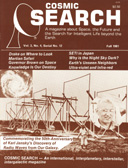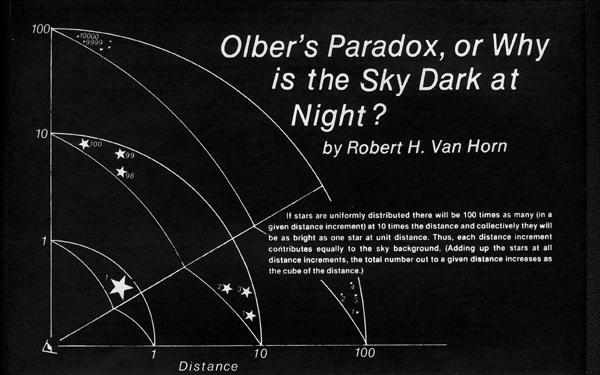![[NAAPO Logo]](../../Images/NAAPOsm.jpg) North American AstroPhysical Observatory (NAAPO)
|
|
Olber's Paradox, or Why Is the Sky Dark at Night?
By: Robert H. Van Horn
Tonight, if the sky is clear, you can go out of doors and make a very significant astronomical observation. You will need no special instruments. Your eyes will suffice. The observation: Note whether the sky is dark or whether it blazes with the light of millions of suns!
It is, of course, a commonplace that the night sky is dark. But that darkness was a puzzle to astronomers and cosmologists from before the time of Newton to the middle of the twentieth century. Newton, and most others during that era conceived of space as three dimensional and infinite. And they thought of time as without beginning or end. Newton's laws of motion and gravity worked as well in calculating the motions of planets, comets, and other bodies. They also worked well in calculating motions of projectiles and machinery. The whole universe was conceived as a giant clockwork whose laws were at last understood...except...
Among the unexplained puzzles were the Milky Way and the nebulosities discovered in various parts of the sky as telescopes got better and better. And the sky was dark at night in spite of the infinity of stars thought to extend throughout what Edmond Halley called "the whole Abyss of Space."
Cosmologists reasoned that the number of stars must indeed be infinite and must extend throughout all space. If not, they would have a center of gravity and over an infinite time they would have gravitated toward one another and all would have coalesced at the center of gravity.
Puzzling over this, Edmond Halley wrote in 1720, "An Argument I have heard urged that if the number of Fixt Stars were more than finite, the whole surface of their apparent Sphere would be luminous for these shining bodies would be more in number that there are Seconds of a Degree in the area of the whole Spherical Surface." Halley recognized that the light from the more distant stars would decrease in proportion to the square of the distance to them. He also recognized that the number of stars at the greater distances would increase in proportion to the squares of their distances. Thus the effects of distance would cancel each other.
Although Halley virtually stated the paradox of the dark sky at night, the full recognition of the paradox is attributed to a German Physician and amateur astronomer, Dr. Wilhelm Olbers. Olbers' paper, "On the Transparancy of the Interstellar Medium," published in the 1826 Astronomical Yearbook, stated, "Should there really be suns in the whole infinite space, they can be at approximately the same distance from one another, and consquently [sic; i.e., "consequently"] the whole sky should be as bright as the sun. Clearly, each line which can conceivably be drawn from our eye will necessarily end on one of the stars and each point on the sky would send us starlight, that is, sunlight."
Olbers concluded that the darkness at night could only be explained if the interstellar medium were not perfectly transparent. He then made some calculations on the opacity of the interstellar medium. Although his calculations are now only a historical curiosity, his name remains attached to the paradox of the dark night time sky.
Today we recognize that the universe and the number of its stars are finite. Moreover, the light from the most distant objects is red shifted, much of it out of the visible range.
So go out tonight and look at the sky. And as you contemplate the darkness you can be aware that you are observing a limited but marvellous universe. There is much more in the darkness than meets the eye.
|


